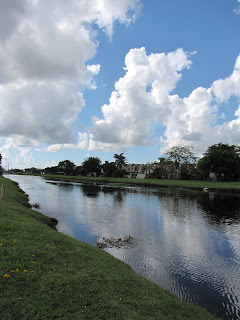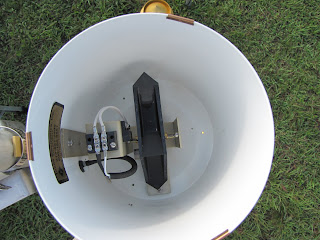
I have been in Homestead since early September focusing exclusively on the Snapper Creek Project - learning the different devices and troubleshooting some discrepancies in the systems. The following is a short summary of this project.
Project objective:
Erected this summer, the weather and soil water monitoring site at Snapper Creek (Miami, FL) is collecting data for use by water managers in Miami-Dade County to develop water and energy conservation measures for urban landscape irrigation systems.

Equipment installed at the site:
1. Wind speed sensor that measures accurately wind speeds in the range of 0 to 100 mph.
2. Temperature (-40o to + 60oC) and Relative Humidity (0 to 98% RH, non-condensing) probes.
3. Two Tipping bucket rain gages with 0.01 inches (0.254 mm) per tip.
4. Three Water content reflectometers to measure soil volumetric water content.
5. Two Soil temperature probes (-35o to + 50oC).
6. Precision Infrared radiometer (Field of view, 22o half angle).
7. Two Soil heat flux sensors (±2000 Wm-2).
8. Two Solar radiation sensors to measure incoming and reflected solar radiation.
9. Net radiometer.







Data collection:
Two Campbell Scientific data loggers (CR800 and CR1000) are used to collect the measured data. The PC400 software is used to download data from the data loggers.

Data Analysis:
To transform data into usable outputs (that include graphs) a program has been developed in VBA excel. This allows for data analysis almost immediately after downloading.

Observations:
· Generally the most sensors are recording weather data accurately. However, one rain gauge over estimates rainfall and a correction factor was developed for this particular rain gauge.

· The soil water content reflectometers underestimate the volumetric water content during unsaturated flow due to the existence of air pockets around the sensor rods. The accuracy of data collected was improved by reinstalling the water content reflectometers using a soil slurry made with sieved soil to minimize air pockets around the sensor rods.

Conclusion:
Data collection at the Snapper Creek site will continue for several years. Ideally, somewhat better understood thanks to what I was able to accomplish this past month.
Data collection at the Snapper Creek site will continue for several years. Ideally, somewhat better understood thanks to what I was able to accomplish this past month.

Nicholas Kiggundu

Great post Nic! As always, nice to have you around for a few weeks. We are really happy with all that you did to help get us back on track. We are missing you already!
ReplyDelete